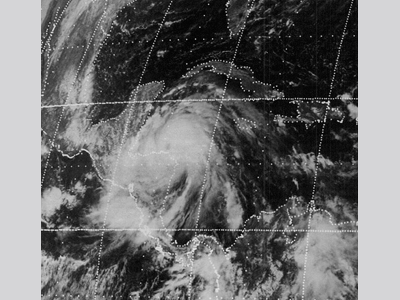Hurricane Fifi was a catastrophic storm that struck Central America in September 1974. Originating from a tropical wave off the coast of Africa on September 8, 1974, the system tracked west/northwest across the Atlantic. The wave did not develop into a tropical depression until 14 September, 97 km (60 mi) south of Haiti. The depression slowly strengthened into a tropical storm just off the coast of Jamaica on 16 September. The storm then intensified quickly into a hurricane 24 hours later. Hurricane Fifi reached its peak intensity, with maximum sustained winds of 177 km/h (110 mph) and a low pressure of 971 mb (hPa), just before it brushed the northern coast of Honduras on 18 September. The next day, Fifi made landfall in Belize as a Category 2 hurricane. After landfall, Hurricane Fifi quickly weakened, becoming a tropical depression late on 20 September.
Though the storm passed to the south of Jamaica as a tropical storm, some regions were still affected by the hurricane and received more than 200 mm (8 in) of rain. Flooding occurred in Kingston, leaving some areas with .61 m (2 ft) of water and damages totaling to hundreds of thousands of dollars with no loss of life reported. In Guatemala, 200 people were killed by severe flooding, making Fifi the worst hurricane to impact the country in nearly 20 years. Chinandega, Nicaragua received 370 mm (14.5 in) of rain in a four-day period as the storm swept through. Belize endured a direct landfall from Hurricane Fifi, however it suffered little damage compared to other countries. Hurricane Fifi devastated nearby Honduras. As the hurricane skimmed the coast of Honduras, it dropped a tremendous amount of rain. In just 36 hours, 610 mm (24 in) of rain fell in the northern, mountainous regions. This immense amount of rainfall triggered mudslides and flash floods and caused rivers and streams to swell which, coupled with the winds, destroyed 182 towns and villages in just 24 hours. Resultant inland flooding caused an incredible amount of damage. The Ulua River Valley was transformed into a lake 32 km (20 mi) wide. In the market town of Choloma, 2,300 people were killed when a natural dam created by landslides over time gave way into a nearby river. About half of Honduras’ food crops were destroyed by the winds and flooding, including coffee crops and 95% of the total banana crop, a major product accounting for some 50% of the country’s exports. The fishing industry also suffered as moorings were destroyed and ships grounded. Along its path, Fifi impacted nine countries, causing over 8,000 fatalities and $1.8 billion (1974 USD; $8 billion 2009 USD) in damage. Most of the loss of life and damage occurred in Honduras. Fast Facts:
Sources:
National Hurricane Center, Hurricane FiFi Preliminary Report (individual scanned pages) Hope, J.R. 1975. Atlantic Hurricane Season of 1974. Monthly Weather Review. 108: 285-300. Pielke Jr., R.A., Rubiera, J. Landsea, C., Fernandez, M.L., and Klein, R. 2003. Hurricane Vulnerability in Latin America and The Caribbean: “A Hurricane in Honduras” Time.com. TIME. Oct. 07, 1974. Web. |


